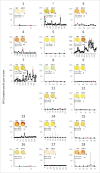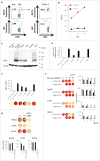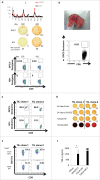Phase I study of glypican-3-derived peptide vaccine therapy for patients with refractory pediatric solid tumors
- PMID: 29296538
- PMCID: PMC5739579
- DOI: 10.1080/2162402X.2017.1377872
Phase I study of glypican-3-derived peptide vaccine therapy for patients with refractory pediatric solid tumors
Abstract
The carcinoembryonic antigen glypican-3 (GPC3) is a good target of anticancer immunotherapy against pediatric solid tumors expressing GPC3. In this non-randomized, open-label, phase I clinical trial, we analyzed the safety and efficacy of GPC3-peptide vaccination in patients with pediatric solid tumors. Eighteen patients with pediatric solid tumors expressing GPC3 underwent GPC3-peptide vaccination (intradermal injections every 2 weeks), with the primary endpoint being the safety of GPC3-peptide vaccination and the secondary endpoints being immune response, as measured by interferon (IFN)-γ enzyme-linked immunospot assay and Dextramer staining, and the clinical outcomes of tumor response, progression free survival (PFS), and overall survival (OS). Our findings indicated that GPC3 vaccination was well tolerated. We observed disease-control rates [complete response (CR)+partial response+stable disease] of 66.7% after 2 months, and although patients in the progression group unable to induce GPC3-peptide-specific cytotoxic T lymphocytes (CTLs) received poor prognoses, patients in the partial-remission and remission groups or those with hepatoblastoma received good prognoses. The GPC3-peptide vaccine induced a GPC3-specific CTL response in seven patients, with PFS and OS significantly longer in patients with high GPC3-specific CTL frequencies than in those with low frequencies. Furthermore, we established GPC3-peptide-specific CTL clones from a resected-recurrent tumor from one patient, with these cells exhibiting GPC3-peptide-specific cytokine secretion. The results of this trial demonstrated that the GPC3-peptide-specific CTLs induced by the GPC3-peptide vaccine infiltrated tumor tissue, and use of the GPC3-peptide vaccine might prevent the recurrence of pediatric solid tumors, especially hepatoblastomas, after a second CR.
Keywords: CTL; glypican-3 (GPC3); pediatric solid tumors; peptide vaccine; phase I.
Figures





References
-
- Rodriguez-Galindo C, Friedrich P, Alcasabas P, Antillon F, Banavali S, Castillo L, Israels T, Jeha S, Harif M, Sullivan MJ, et al.. Toward the Cure of All Children With Cancer Through Collaborative Efforts: Pediatric Oncology As a Global Challenge. J Clin Oncol. 2015;33:3065-73. doi:10.1200/JCO.2014.60.6376 - DOI - PMC - PubMed
-
- Heiner JP, Miraldi F, Kallick S, Makley J, Neely J, Smith-Mensah WH, Cheung NK. Localization of GD2-specific monoclonal antibody 3F8 in human osteosarcoma. Cancer Res. 1987;47:5377-81. - PubMed
Publication types
LinkOut - more resources
Full Text Sources
Other Literature Sources
Molecular Biology Databases
